Your chickens will need properly formulated chicken feed that is the correct type for their age, for growth, sustenance and to produce eggs if they are hens of egg laying age. There are many old wives tales and alternative views on feeding, some say it’s marketing that has created all of these feeds and hens will survive well on wheat and others will say their grandad never had layers pellets and just fed his hens kitchen scraps! Formulated poultry feeds didn’t exist until recently, primarily created thanks to commercial research on hens diets as we tried to squeeze more and more eggs out of hens.
In days gone by though when ‘grandad fed scraps’, pure breeds were kept for eggs and they were fed grain mixes or dried mash chicken feed that had meat or fish meal added to increase the protein content. Hens would free range over a large area and could also supplement their diet with what they could forage. Bugs, insects and worms are all valuable sources of protein, not forgetting a good selection of greens providing vitamins and minerals.
“Grandad’s chickens didn’t get chicken feed and survived on kitchen scraps but they could free range to top up their diet on protein, vitamins, minerals and calcium from the fields or orchards they grazed. They didn’t produce anything like the number of eggs modern hybrid hens or some pure breeds produce.”
So in short, if you don’t feed a proper formulated layers feed to your hens, they won’t be able to keep up the demands that egg-laying puts on their bodies.
Layers Feeds and Protein
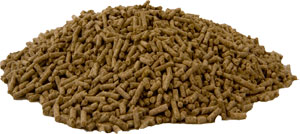 Chickens require protein to produce feathers and eggs as well as to grow. The amount of protein in their diet is important and you will see on the ingredients on the back of bags of commercial feeds the percentage of protein that they contain. It is higher in ‘Growers Pellets’ for example to enable chickens to grow and produce feathers. You will find that chickens stop laying eggs when they moult (lose their feathers and regrow new) as they are diverting protein from egg production to feather production. During the moult, you can scatter a handful of cat kibble in the run which helps them to top up with protein. Do not use dog food as most of the protein is derived from cereals.
Chickens require protein to produce feathers and eggs as well as to grow. The amount of protein in their diet is important and you will see on the ingredients on the back of bags of commercial feeds the percentage of protein that they contain. It is higher in ‘Growers Pellets’ for example to enable chickens to grow and produce feathers. You will find that chickens stop laying eggs when they moult (lose their feathers and regrow new) as they are diverting protein from egg production to feather production. During the moult, you can scatter a handful of cat kibble in the run which helps them to top up with protein. Do not use dog food as most of the protein is derived from cereals.
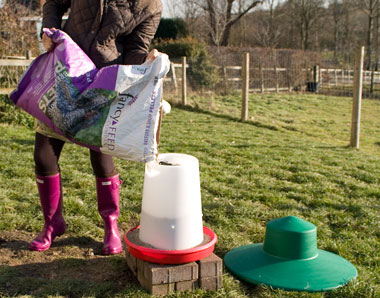
Commercial feeds contain the right balance of nutrients & can be fed ad-lib in hoppers if kept dry. This one has a rain hat.
Commercial chicken feeds have been well researched and contain the correct balance of minerals and nutriets required by chickens as well as sufficient protein and calcium which is essential for egg shell production. Layers pellets for example are around 16% protein. Wheat is about 10% protein and lacks essential vitamins that are required by chickens.
Formulated feeds come as pellets or mash and should be fed ad-lib so hens can take what they want as they need it. This type of feed must be kept dry or it will soon spoil. The feeder and rain hat shown above is the only sort I have found that really does keep the feed dry. Most have a hole in the top of the hat for a handle or for hanging and this lets water in. A feeder and rain hat similar to this one can be bought from Omlet.
Eggs are made up of around 80% protein so if there’s a shortage of protein in their diet, egg laying will be the first thing they your girls cut back on!
There is more information on the poultykeeper.com site which has a very good page of feeding chickens and chicken feed.
Mixed corn
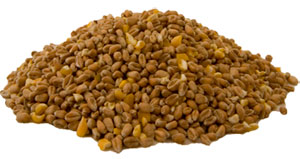 Mixed corn is usually 80 to 90% wheat and 10 to 20% maize. It is useful as a scratch feed, it keeps hens active, scratching around looking for it but should only be considered a treat. A handful per hen thrown late afternoon helps them to have a full crop overnight.
Mixed corn is usually 80 to 90% wheat and 10 to 20% maize. It is useful as a scratch feed, it keeps hens active, scratching around looking for it but should only be considered a treat. A handful per hen thrown late afternoon helps them to have a full crop overnight.
The maize (yellow in colour) is very fattening but can be useful during very cold weather to help your hens keep warm – I increase my girls’ ration of corn when it is cold over the winter, after they have finished moulting (they need lots of protein during the moult) since they are not laying eggs and need a little extra fat to burn in order to keep warm.
If you feed too much corn, your hens will get fat and fat hens don’t lay eggs!
Household scraps
Feeding household scraps is no longer allowed according toi DEFRA and can be a bit hit and miss anyway. You don’t really know what a hen is getting and the diet is very unbalanced. It is for this reason that scraps used to be mixed into a mash by using layers mash and water (which can be warm in winter). The mixture should be a sort of crumbly mix, not too wet but not too dry. Feeding scraps should be limited to at most 25% of a hens diet so as not to tip the balance too far one way or another.
Greens
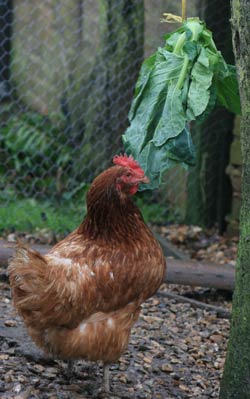 Ample green stuff should be provided for your hens. Grass cuttings, weeds and off-cuts from cabbages, cauliflowers and other greens can be provided at minimal cost. Lettuce should be fed in moderation because it has very little nutritional value (very little Protein and Energy / Calories) and avocado pear is poisonous to hens but most other greens that come from the kitchen will be appreciated by your girls. Try hanging greens in their run, just a little higher than they can reach. As they eat them, they will need to jump to get the last bits so will be getting exercise at the same time as their greens! Win-win!
Ample green stuff should be provided for your hens. Grass cuttings, weeds and off-cuts from cabbages, cauliflowers and other greens can be provided at minimal cost. Lettuce should be fed in moderation because it has very little nutritional value (very little Protein and Energy / Calories) and avocado pear is poisonous to hens but most other greens that come from the kitchen will be appreciated by your girls. Try hanging greens in their run, just a little higher than they can reach. As they eat them, they will need to jump to get the last bits so will be getting exercise at the same time as their greens! Win-win!
If you have an area in which you can grow cabbages in your garden, it may be worthwhile thinking about growing a row for the winter. Cabbages will sit there in the cold, perfectly preserved until picked. You will need to keep them covered with fleece when there are cabbage white butterflies around but don’t worry if they are a little eaten, the chooks won’t mind!
Mealworm treats
Many chicken keepers like to buy mealworms or chicken treats containing these. Chickens love these and are easily tamed by using such tasty treats, however you should keep in mind that animal by-product regulations mean that mealworms are not really allowed to be fed to poultry.

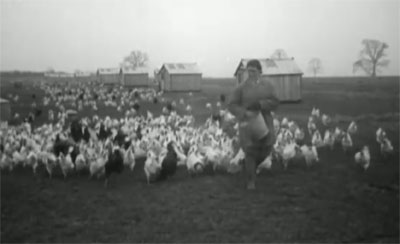

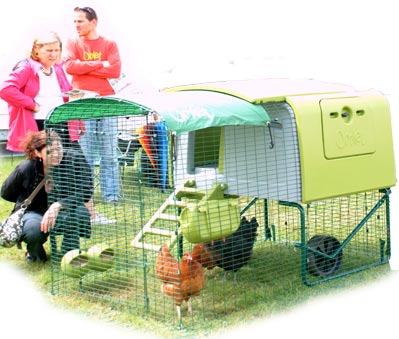


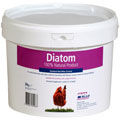
Hey, I’m a student considering keeping some chickens in my garden… I work in a shop where i usually get plenty of leftover bread and a fair bit of leftover meat, how good is this for chickens to eat? And what other things would i need to supplement their diet with? ta
Firstly, Defra’s regulations don’t allow the feeding of meat, fish and most other animal products to pigs or poultry. It is in fact an offence to allow them to have access to it. It also includes ‘catering waste’ from commercial establishments (which would cover you), even vegetarian food so technically you couldn’t feed anything to them from the shop.
Finally… this isn’t a very good diet for chickens and they will not be receiving the right nutrients and it would be too difficult to work out what they needed to get everything they needed to be healthy and lay eggs… Sorry!
Hi just a thought the problem with rats and mice. What about keeping ferrets and just walk them around the coop when the chicks are sleeping. I had a huge problem with rats, got some ferrets and walk them around the garden and as yet have not had 1 rat visit. I dont go ratting as such I think the rat is put off by the scent of the ferret which is not that bad.
Umm yes I guess if it works and you have a ferret.
Hi ….. We are new to keeping chickens …. hens are laying … one of our hens ( berril ) has just started to lose her kneck feathers … no sore,s no redness …. they have vitimins.. eating well laying egg,s ok …. can you advise what we should do … thank you
At this time of year, hens will usually go into moult and look very scruffy as they lose their feathers and re-grow new. Once the re-growth starts, they will usually stop laying eggs as they use the protein that normally goes into egg production to produce new feathers.
This is the most probable cause however it could also be fether pecking or as simple as she’s putting her head through a fence to reach some grass and rubbing her neck.
Hi, We have 13 chickens in a coop which there is no grass in it, and they cant free range due to the dogs. I give them a 1/2 scoop of 3-way grain twice a day ( when i catch my horses they expect a treat too) and they get layers feed ad-lib. And scraps and grass clippings when we have them, which is not very often. Are they getting enough or should we buy some alfala to give them for greens if so can we buy the alfala cubes? Thanks! Also we need to buy some grit, they dont have anything for them, I give them sand occassionally.
If they don’t have access to grass then I would try to supply them with some varied greens ad lib too. For example you can hang a cabbage upside down on a string (a little too high and they will jump, getting some good exercise) or provide them with grass cuttings / weeds or anything else green you can find around the fields or hedgerows. When it is really cold, sweetcorn (maize) can be hung up too – but don’t overdo this as it’s very fattening. If you have horses, perhaps you could consider fencing an area that the dogs can’t get to so the chickens can graze with the horse? If you use electric fences, extending a wire along the outside of the fence would stop predators, dogs included. See my page on electric fencing for more ideas.
Hello there,
I have 4 chickens that i have had for 2 weeks now, they are 5 to 7 months old and vaccinated.
I follow all your tips and have a question.
I have yet to have any eggs from my chickens, people are telling me to feed them castor oil or olive oil. Is this true?
What can you advise, are they just settling in and i am expecting too much or should they have started laying by now.
Many thanks
jon
Chickens normally start laying around 22 – 24 weeks old so they should be ready to start laying… however as the daylight hours fall, they stop laying and the decreasing day length is probably stopping them from coming into lay. Don’t worry, when the spring comes, you will get bigger eggs and their laying season will be longer. If they start now, you would get some eggs through the winter but they will be small eggs and they will stop laying earlier next year. I wouldn’t worry about the oil. Cod Liver oil was traditionally used to supply vitamin D for birds kept out of the sunshine and can be useful now and again for shiney feathers on show birds but you shouldn’t need this with a correctly formulated poultry feed and regular outdoor excercise. A lot of the old 1930’s poultry books actually show poultry shed designs that include a ‘sun porch’ for birds to be able to get some sunlight to save on the Cod liver oil.